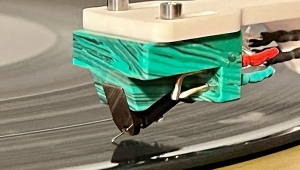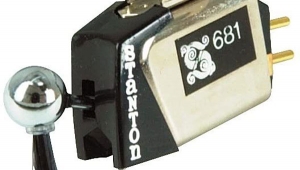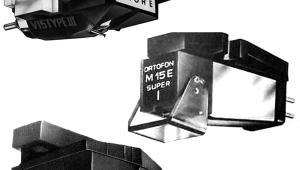| Columns Retired Columns & Blogs |
Clearaudio Virtuoso Wood MM phono cartridge Page 2
I immediately noticed the Virtuoso Wood's superiority in the midrange, particularly on vocals, both male (Mighty Sam McClain, Give It Up to Love, AudioQuest AQLO1015) and female (Janis Ian, Breaking Silence, Analogue Productions APP027). Voices were reproduced with more detail and delicacy, and had a much richer presentation, with more dimensional body but with no trace of euphonic coloration. I noted superior detail resolution and transient articulation on piano and guitar passages, with improved ambience and air as well as longer decay times. This improvement extended into the high frequencies.
But it was in the highs that a paradox seemed to emerge. The Virtuoso shared the Aurum Beta S's pristine, extended, uncolored high frequencies, but seemed a bit sweeter and airier, with more detail. However, there was no touch of softening or rolloff—in fact, it seemed as if the transient attacks on percussive instruments were faster still, but without a trace of hardness or edge. The Virtuoso Wood's sonic signature seemed a bit more liquid than that of the slightly drier Aurum Beta S, but without a trace of softening, coloration, or loss of detail.
The Virtuoso Wood's performance was consistent at the opposite frequency extreme. Like the Aurum Beta's, the Wood's lower to upper bass was clean, fast, and uncolored, with plenty of bottom-end slam, but with the Virtuoso I could hear more of the textural wood of both electric and acoustic basses in all types of music. My notes from listening to Dean Peer's Ucross (Jazz Planet JP 5002-1): "extended low bass, fast but rich and woody, powerful without being sharp, but delicate, with extended upper harmonics and natural decay."
A quick spin of Classic Records' reissue of Miles Davis' Kind of Blue (Columbia/Classic CS 8163) indicated that the Virtuoso Wood may be the affordable cartridge for jazz lovers. Both Davis' trumpet and John Coltrane's tenor sax had bite and tension while sounding silky and sweet. My notes: "more detail, but more relaxed and less analytical, without a trace of coloration." With this recording, I also found myself analyzing the dynamics of Jimmy Cobb's technique of positioning his drumstick on the ride cymbal.
I had a similar experience listening to the bite of Davis' trumpet on "Yesterdays," from the 10" reissue of his Young Man with a Horn (Blue Note/Classic LP 5013). The room disappeared, and the ensemble interplay was dynamic and organic. Finally, I put on Louis Armstrong and Duke Ellington (Roulette/Classic SR52074) and studied in detail the interplay of Barney Bigard's clarinet and Trummy Young's trombone in "The Beautiful American."
When I focused on the pitches of the drum skins and the ambient body and decay of each percussion instrument in John Cage's Third Construction, from Pulse (New World/Classic NW319), I was able to follow, without strain, the subtle contrapuntal motifs between pairs of instruments in this revealing and natural recording. The Virtuoso Wood's superb ambience retrieval and soundstaging capabilities made it very easy to hear hall ambience and instrument positions on such well-recorded orchestral blockbusters as Stravinsky's The Firebird (Mercury Living Presence/Classic SR90226) and Mahler's Symphony 2 (Vanguard/Classic VCS 10003). With the Mahler, I can't recall having heard a more natural reproduction of massed strings from a phono cartridge. When I listened to Messiaen's Turangalîla Symphony (EMI SLS 5117), I found myself studying the piano's hammers. They sure sounded to me like the hard-polished hammers of the German Renner action found on Steinways made in Hamburg. These recordings convinced me that the Virtuoso Wood may be the affordable cartridge of choice for the lover of classical music.
- Log in or register to post comments



































